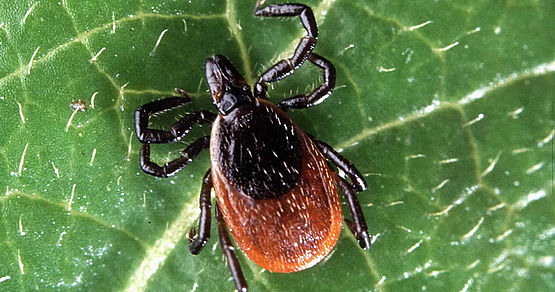Lyme Disease

Be on the lookout for ticks!
The deer tick or black-legged tick (Ixodes scapularis) can transmit Lyme disease and anaplasmosis. Since ticks are increasingly common in Québec, it's important to take certain necessary precautions.
When taking part in outdoor activities from April to November:
- Use a mosquito repellent that contains DEET or icaridin.
- Wear long clothing and cover your body as fully as possible.
- Walk along cleared trails and avoid rubbing up against any vegetation.
- When coming in after the activity, take a shower. Then check your body for ticks and remove any you find.
- Protecting yourself from mosquito and tick bites advices.
Lyme Disease
Common Symptoms
The most common symptom is a rash around the tick bite that is present in 60% to 80% of infections. The rash expands daily, generally reaching 5 cm in diameter. Other symptoms may be associated with this disease, including: fever, fatigue, headache, stiff neck, muscle pain or joint paint.
Persistent symptoms (post-Lyme disease syndrome)
Some people who have been diagnosed with Lyme disease may have symptoms that persist beyond 6 months after treatment. For example, severe fatigue, headaches, muscle aches, difficulty concentrating or other symptoms. This can be called post-Lyme disease syndrome.
At the CIUSSS de l'Estrie – CHUS, a specialized clinic offers medical support to people with post-Lyme disease syndrome. For more information and to find out how to access the clinic
Anaplasmosis
Common Symptoms
- Fever and chills
- Fatigue
- Headache
- muscle pain
- Nausea, vomiting, diarrhea or loss of appetite (about 20% of cases)
- In rare cases, a rash (less than 10% of cases)
Most people experience mild to moderate symptoms, but those who are immunosuppressed, aged 50 and older or who delay consulting after the onset of the first symptoms may present with more severe cases.
Treatment
Unlike Lyme Disease, there is no preventive treatment for anaplasmosis after a tick bite. Even if the tick has been removed within a 24-hour window, you may still develop anaplasmosis. It is therefore essential to apply preventive measures before going to the great outdoors in order not to get bitten by a tick.
En cas de piqûre
Have you been bitten by a tick?
Were you bitten by a tick in Estrie?
- Remove the tick with a fine tweezers, such as an eyebrow tweezersThis link will pop up in a new window..
- Put the tick in a container (e.g., a pill bottle). Write down the date and location where you were bitten. This information could be useful if you consult a doctor.
- See your doctor or go to a walk-in medical clinic if Lyme-disease or Anaplasmosis symptoms appear from 3 to 30 days after you were bitten.
Useful Links
- Lyme-disease information sheet | Before a Tick Bites You...
- Public Health Agency of Canada | Lyme Disease
- Institut national de santé publique du Québec | La maladie de Lyme et les maladies transmises par tiques (interactive map by municipality) (French)
